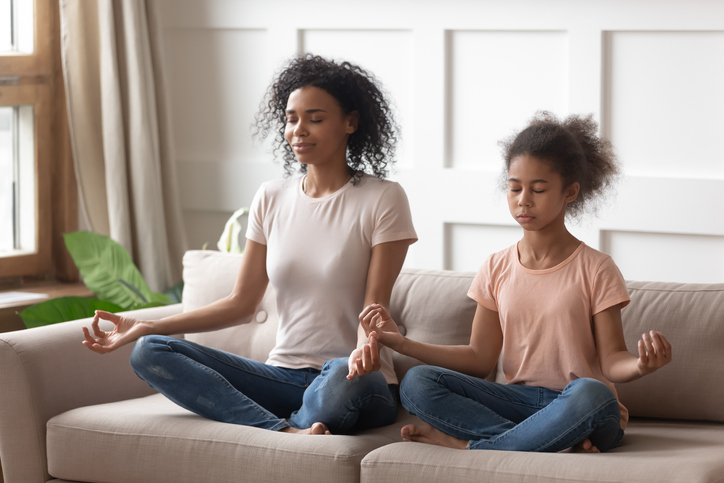By Pam Melyan-Bratton | Contributor
School, homework, family, friends, chores, video games…the list of what is whirling through our children’s brains is seemingly endless. How can we help our kids find the calm among the storm? “In a world where many things are competing for our attention, there has never been more of a need for meditation as there is now,” April Linson, breathwork healing facilitator and certified yoga instructor said.
Starting at a very young age, children can reap the benefits of meditation and mindfulness. Linson, who has taught and practiced meditation for over eight years, says that children have an innate ability to tune in to the frequencies of their surroundings, “the natural rhythms within nature and the emotional undercurrents of their caretakers and peers.” Meditation can be a helpful tool for them to connect to their own emotions and can offer them a way to process their energy.
“With mindfulness practices, staying in the present is the most important piece, not worrying what happened before or what’s to possibly come.”
Start Simple
Linson suggests starting with about 5 to 10 minutes of meditation practice time. When starting a mindfulness practice with children at a young age, it can be helpful to form a schedule. “Repetition is also key in learning and helps to make new habits. Begin with anywhere from five to ten minutes and add on as the child becomes more familiar with the practice,” Linson recommends.
Mary N. Budd, MA is a school counselor and agrees that simplicity is key when working with her students. “My idea of mindfulness practice for middle school students is to keep it simple. It is always about compassion, self-care, staying present and aware of breath.”
Wiggle Worms
When preparing a child to meditate, Linson recommends to get the wiggles out. “Children can be curious and easily stimulated, so before bringing them to a place where they will sit still or lay for a period of time, have them do a short energetic activity like a freeze dance,” she suggests. “Movement prior to coming into stillness can help, and keeping the practice short and simple will help set the foundation for longer practices down the road.”
Mindfulness Methods
Budd teaches her students mindful breathing for one minute using that time to help students focus on their breath. “I will explain that this is oftentimes not easy to do and if their mind wanders, as it will do, just bring the attention back to the breath. After the minute resumes, I will explain that it simply was a moment to pause and be in the moment.”
Budd meets with students in groups and also works one-on-one with students when necessary. She runs a Lunch Bunch group at her school and begins the time with a Body Scan activity. “This is an activity to tune in to your body,” Budd explains. “Scan your body and notice any physical sensations or emotions. Discharge any unpleasant sensations, emotions or feelings on the ‘out’ breath. Notice any pleasant ones and let them fill you up on the ‘in’ breath. This activity sets the tone for our time together including interactions with others and even themselves.”
Linson practices two forms of meditation with little ones. Walking meditation allows the child to experience movement during the mediation. Linson encourages bare feet “as it helps to bring some awareness and connection to the earth and to the foundation of their little bodies.”
While walking, children can choose an affirmation such as, “I am strong,” or “I am here,” and they can say it aloud or in their heads, Linson says.
“We begin the walking meditation by bringing attention to our feet. The first step begins by bending one knee and lifting the foot completely off of the ground as we take the first step. Then we mindfully place the heel down first and then the middle of the foot and finally the toes. At this point, the affirmation is stated and then we begin to step with the other foot repeating what we did on the first side,” Linson says. Try this for a few minutes or for as long as their attention span can reach.
Linson also teaches breathwork meditation to children young and old. “To begin, I have the child close the eyes and place one hand on the belly and one hand on the heart,” Linson says. She has the child listen and name the sounds she hears. “Then I have them take a deep breath in and ask them to listen to what their breath sounds like. I ask them to also see if they can feel their heart beating. Tracing the breath through the nostrils, we follow the path of the air down the back of the nose as it fills the belly, ribcage and chest. Then we follow the air in the opposite direction on its way out.”
Calm, Cool and Collected
Before students leave Budd’s office, she encourages them to pretend they have on a tool belt filled with a new tool or strategy they can use after trying it out in her office. “With mindfulness practices, staying in the present is the most important piece, not worrying what happened before or what’s to possibly come.”


